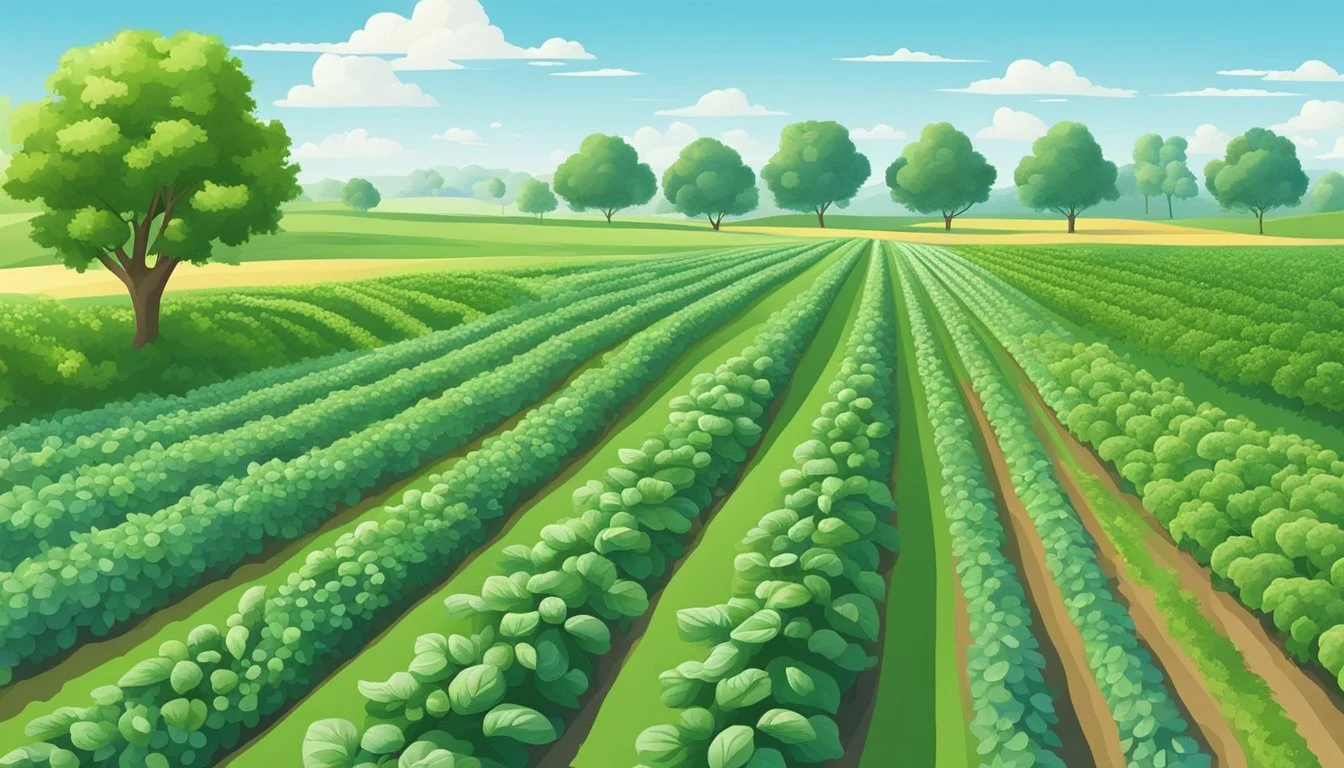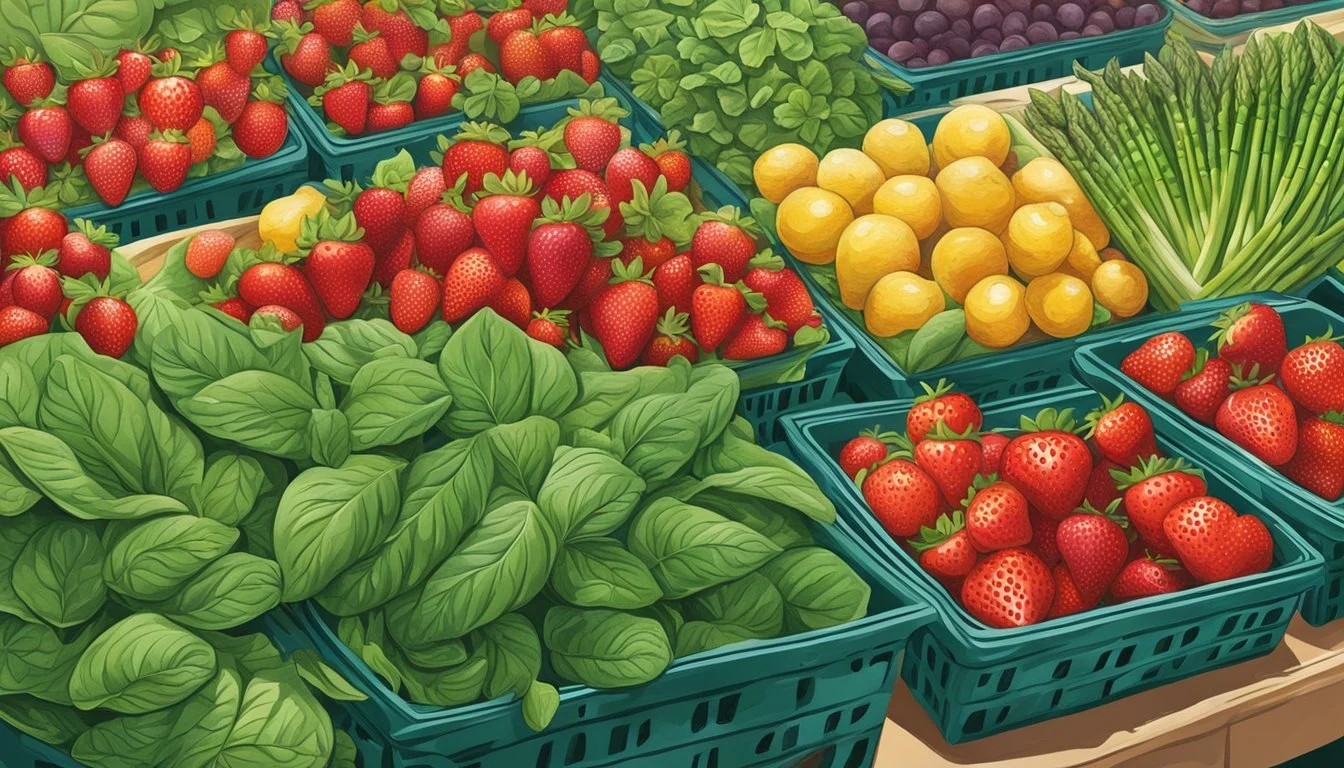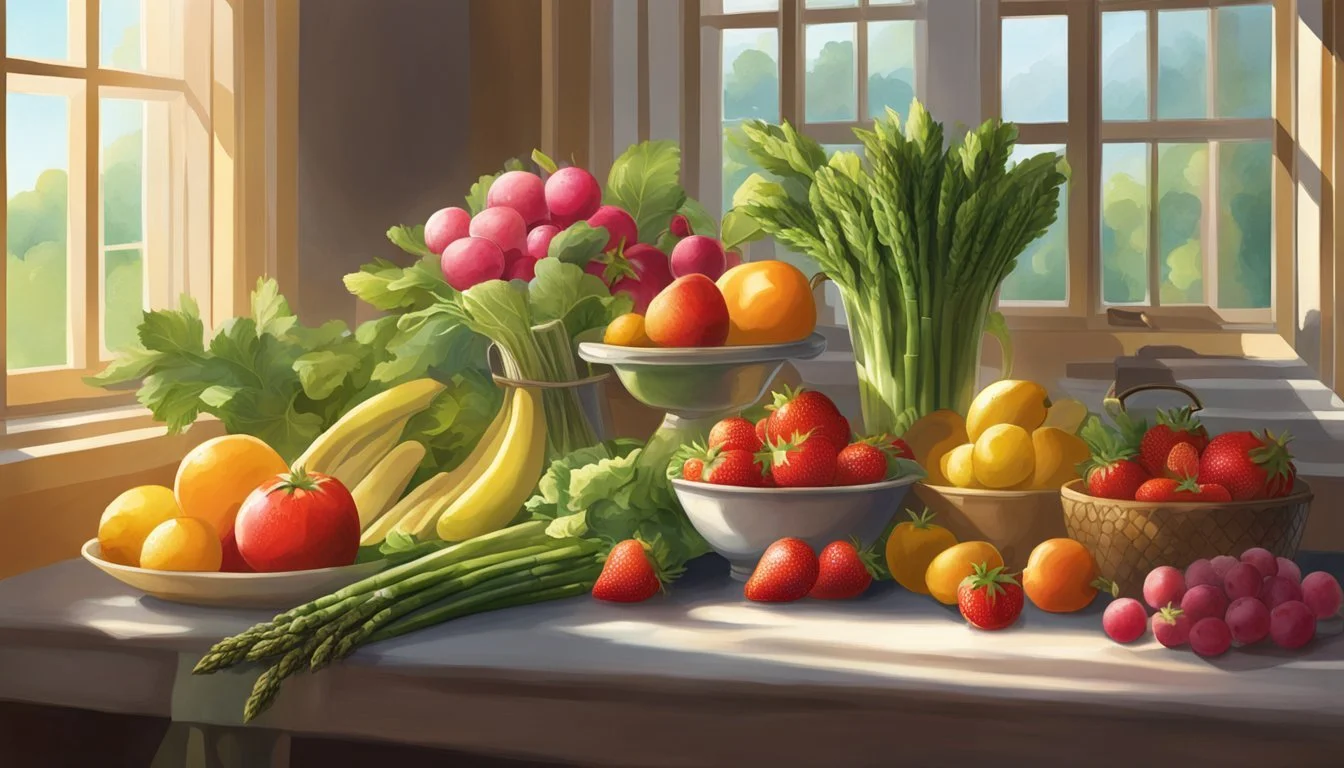Maryland Seasonal Fruit & Vegetables in March
Your Fresh Produce Guide
This Article is Part of our Maryland Seasonal Fruit & Veg Calendar
In March, residents of Maryland can enjoy a selection of seasonal produce that not only promises freshness but also supports local agriculture. As the winter months draw to a close, the state’s farms begin to offer a variety of fruits (What wine goes well with fruit?) and vegetables that are harvested at their peak. While many summer crops are not yet available, March provides its own unique bounty that includes storage crops still available from the previous season as well as the early spring offerings beginning to make their appearance.
While fruits are more limited during this time, the focus predominantly shifts to vegetables. Hardy greens such as kale (What wine goes well with kale?) and collards withstand the cool temperatures of early spring, offering nutrition and flavor to local dishes. Root vegetables, like carrots (how long do carrots last?) and beets that have been stored from prior harvests, continue to be available and add sweetness and texture to meals. As the month progresses, Marylanders can look forward to the arrival of spring's fresh produce, with each passing week offering more variety.
The emphasis on seasonal eating aligns with a growing consumer interest in sustainability and farm-to-table dining. March is a transitional period in Maryland’s agricultural calendar, but local markets and farms still provide an array of options for those seeking to incorporate seasonal freshness into their cooking. The state's commitment to its agricultural heritage is evident in the availability and quality of the produce offered during this time.
What's in Season in Maryland?
As March heralds the onset of spring in Maryland, a variety of fresh produce begins to emerge at local markets. This month is known for an overlap of the last winter offerings and the first tender shoots of spring.
Early Spring Produce
March marks the transition from winter to spring in Maryland, with early spring produce beginning to make an appearance. Shoppers can expect to find kale and spinach (What wine goes well with spinach?), which are hearty greens that thrive in the cool start of the season. Leeks, with their mild onion-like flavor, are also reaching their prime. Additionally, various spring greens are becoming available, offering a fresh addition to meals.
March Specific Vegetables
As the ground thaws, March specific vegetables become more prevalent. Asparagus spears start poking through the soil, a true sign of spring. Broccoli (how long does broccoli last?)and cauliflower begin to flourish, providing a rich source of vitamins and minerals. Root vegetables, such as carrots, are still in good supply from cold storage or overwintered crops. Cabbage and peas are also among the vegetables that Marylanders can enjoy fresh during this month.
Asparagus: Emerging in March
Broccoli: Available
Cauliflower: Available
Cabbage: In Season
Leek: Peaks in March
Peas: Start to appear
Carrots: Still available from storage
Spinach: Hardy options in markets
Kale: Continues from winter
March Specific Fruits
When it comes to March specific fruits, options are fewer as many fruit trees and plants are just beginning to wake from dormancy. However, cold storage techniques allow for certain fruits to still be enjoyed. Apples (how long do apples last?) and pears continue to be available from such storage, maintaining the presence of fresh, crisp flavors in the local fruit selection. These storage techniques ensure that consumers can enjoy some of Maryland's orchard fruits even while waiting for new fruit crops to mature in the coming months.
Apples: Cold storage varieties available
Pears: Cold storage options on hand
Seasonal Harvesting and Planting Calendar
In March, Maryland’s gardeners prepare for planting cool-weather vegetables while harvesting storage crops and greenhouse-grown produce.
Vegetable Planting Calendar
The window for planting cool-season vegetables begins in March. The focus is on crops that can withstand the last frosts commonly experienced in Maryland during this time.
Spinach: It can be planted as early as the ground can be worked. Spinach prefers cool temperatures and can germinate in soil temperatures as low as 35°F.
Lettuce: Similar to spinach, lettuce seeds can be sown directly into the garden in March. Hardy varieties are recommended.
Radishes: They are ideal for early planting due to their quick growth rate, taking only three to four weeks to reach maturity.
Table 1: Vegetable Planting Guide for March
Vegetable Planting Dates Method Spinach Early March Directly sow Lettuce Early March Directly sow Radishes Early March Directly sow
Fruit Harvest Dates
Fruit availability in March largely depends on storage and greenhouse production, as most fruit plants are not in the harvest season outdoors.
Apples: Stored apples from the previous season are still available and can be found in markets.
Pears: Similar to apples, pears harvested in the fall and properly stored may still be available for purchase.
Table 2: Fruit Availability in March
Fruit Availability Source Apples Available Storage/Greenhouse Pears Limited Availability Storage/Greenhouse
Maryland's March brings an opportunity for gardeners to plant hardy vegetables and enjoy stored fruits reflecting the remnants of the previous season's bounty.
Benefits of Seasonal Eating
Consuming seasonal produce in March ensures individuals receive optimum flavor and nutritional value, while also supporting environmental sustainability.
Nutritional Advantages
Seasonal fruits and vegetables harvested in March generally possess a higher nutrient content. The proximity of local farms means that produce like spinach, kale, and radishes, which are in season, reach consumers swiftly after harvest. This quick transition from farm to table allows seasonal produce to retain more vitamins and minerals, offering a more nutrient-dense dietary choice. The flavor, too, is markedly enhanced—fresh, seasonal items are recognized for their superior taste and quality.
Environmental Impact
Seasonal eating in March supports local farming operations, which often employ practices that are more attentive to land stewardship, demonstrating a commitment to sustainability. Choosing local seasonal produce reduces the carbon footprint related to long transportation distances. Moreover, it bolsters the local economy by keeping expenditures within the community and reducing the necessity for extensive and unsustainable farming methods that can be detrimental to the environment.
Exploring Maryland Markets
In March, Maryland markets are bustling with activity as farmers and vendors offer a wide assortment of fresh, locally-grown produce. Shoppers have the chance to support local agriculture and experience the freshness of spring harvests.
Farmers' Market Guide
Maryland hosts an array of farmers' markets where one can find a diverse selection of fruits and vegetables. In March, the options may include:
Greens: Various types of kale, spinach, and other leafy greens are often available.
Root Vegetables: Look for products like beets and carrots, which may have been overwintered or stored.
Farmers' markets are typically open on specific days of the week. Customers are encouraged to visit the Maryland's Best website for an up-to-date Maryland Farmers Market Directory, which can guide them to the nearest market locations, operating hours, and additional details.
Finding Organic Produce
For those seeking organic produce in Maryland, there are several markets dedicated to organically grown fruits and vegetables. Many of these markets ensure that their products are cultivated without synthetic pesticides or fertilizers, adhering to organic farming standards. It is recommended for shoppers to inquire directly with vendors about their organic certifications and farming practices to verify the authenticity of the organic produce.
Both conventional and organic growers are looking forward to the upcoming growing season and often have an abundance of greens and storage crops available for health-conscious consumers. Amidst the early spring selections, one can also find artisanal goods and locally-produced items that reflect the richness of Maryland's agricultural community.
Preservation Techniques
March in Maryland offers an array of fruits and vegetables that can be preserved to extend their shelf-life. Individuals interested in savoring the seasonal bounty year-round can utilize methods like canning and freezing.
Canning Seasonal Produce
Canning allows one to enjoy the fruits and vegetables long after their harvest season. It involves placing foods in jars or similar containers and heating them to a temperature that destroys microorganisms and inactivates enzymes that cause food spoilage. Maryland's March produce often includes items perfect for canning such as:
Fruits: Apples and pears for making preserves and jams.
Vegetables: Spinach and other leafy greens for pickling or pressure canning.
When canning, it's imperative to follow these steps:
Select fresh, high-quality produce.
Sterilize canning jars and lids.
Prepare produce by washing and chopping as needed.
Use a water bath for high-acid foods like fruits and pickles.
Use a pressure canner for low-acid foods like most vegetables.
Freezing for Longevity
Freezing is a convenient method to preserve the nutritional value of produce with minimal loss of texture and flavor. Vegetables and fruits suitable for freezing include:
Fruits: Berries or sliced peaches, usually flash-frozen on trays before being stored in bags.
Vegetables: Broccoli and snap peas, blanched briefly before freezing to preserve color and texture.
To effectively freeze seasonal produce, one should:
Blanch vegetables before freezing to stop enzyme activity.
Package properly in airtight containers or freezer bags to prevent freezer burn.
Label clearly with content and date of freezing.
By following these methods, people can ensure that the vibrant flavors of Maryland's March produce are available well beyond the season.
Incorporating Seasonal Produce into Meals
March in Maryland provides a bounty of seasonal produce that one can incorporate into meals for fresh flavors and nutritional benefits. This section highlights how to utilize these ingredients in healthy recipes and offers cooking tips for beginners.
Healthy Recipes
Salads:
Kale and Apple Salad: Combine chopped kale, diced apples, shredded carrots, and sliced red onions. Dress with a vinaigrette made from apple cider vinegar, olive oil, honey, salt, and pepper.
Main Dishes:
Roasted Butternut Squash Soup: Cube butternut squash (how long does butternut squash last?), toss with olive oil, and roast until tender. Puree with vegetable broth (how long does vegetable broth last?), sautéed onions, garlic, and a pinch of nutmeg (how long does nutmeg last?).
Sides:
Sautéed Green Beans: Trim fresh green beans and sauté with minced garlic, olive oil, and sliced almonds until crisp-tender.
Cooking Tips for Beginners
Understanding Flavor Pairings:
Squash pairs well with nutmeg and cinnamon for sweet dishes, or sage and thyme for savory recipes.
Beans benefit from aromatics like garlic and onions to enhance their earthy flavor.
Cooking Techniques:
Roasting vegetables like butternut squash intensifies their natural sweetness and adds a satisfying texture to soups or salads.
Steaming green beans preserves their color and nutrients, making them a healthy addition to any meal.
By focusing on seasonal produce such as beans and squash, one can create meals that are not only flavorful but also nutritious. With these simple recipes and tips, even cooking novices can prepare dishes that celebrate the fresh flavors of March in Maryland.
Gardening Tips for Home Growers
March is a pivotal time for gardeners in Maryland, offering a window for starting vegetable gardens and planting herbs. With a calculated approach, home growers can optimize their efforts for a successful harvest.
Starting a Vegetable Garden
For those preparing to cultivate their own vegetables, it's important to consider the local climate. Maryland's diverse weather requires attention to frost dates—cool-season crops can be planted a few weeks prior to the last expected spring frost. Gardeners should prioritize soil preparation by tilling and enriching the soil with compost for a nutrient-rich foundation. For March planting, peas and carrots are excellent choices to begin with, as they are frost-tolerant and can thrive in cool soil. Here’s a quick guide to planting schedules:
Peas: Plant as soon as the soil can be worked. Sow seeds 1 inch deep and 2 inches apart in rows, spacing rows 18-24 inches apart.
Carrots: Sow directly in the garden 3-4 weeks before the last frost date. Plant seeds ¼ inch deep with 2-3 inches spacing in rows that are 12-18 inches apart.
Herb Planting and Care
Herb gardens add both flavor and fragrance to the home landscape. When planting herbs in March, consider starting with thyme and rosemary, both of which can be planted after the danger of heavy frost has passed but can tolerate light frosts. Herbs require well-draining soil and should be placed in an area that receives ample sunlight.
For thyme:
Plant in a sunny spot with well-drained soil.
Space plants approximately 12 to 18 inches apart.
For rosemary:
Prefers full sun and well-drained, loamy soil.
Space plants at least 3 feet apart as they can grow quite large.
Consistent care is crucial; a light layer of mulch can help retain soil moisture and temperature. Regular watering is important, but one must avoid overwatering herbs to prevent root rot or other moisture-related diseases.
Conclusion
March in Maryland marks the transitional period when winter produce begins to give way to early spring offerings. Consumers looking to support sustainable practices can take advantage of this period by prioritizing locally-sourced fruits and vegetables, which supports the local economy and reduces the carbon footprint associated with long-distance transportation.
Locally harvested produce during this time includes overwintered vegetables as well as some early spring crops. Here is a sampling of what shoppers might find at Maryland farmers' markets:
Vegetables:
Asparagus
Brussel Sprouts
Cabbage
Carrots
Greens (e.g., Kale, Collards)
Fruits:
Stored Apples (from the previous fall)
Choosing these items ensures peak freshness and flavor while enabling a deeper connection with the seasonal rhythms of the region. The act of eating locally also encourages the community to engage with Maryland farmers, fostering a beneficial relationship between producers and consumers.
As spring progresses, the variety of available produce will increase, making March an ideal time to enjoy the last of winter's bounty while anticipating the abundance of the coming seasons. For those planning their meals or even their garden planting schedules, being in tune with this cycle not only benefits personal health but also contributes to the wider context of environmental stewardship.







